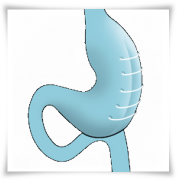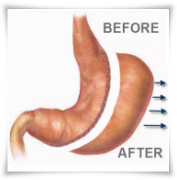Facts On Gastric Sleeve Surgery
This procedure is a relatively new approach, so in this article we are going to give you the facts on gastric sleeve surgery.
Gastric sleeve surgery is proving to be an effective procedure that can help you lose excess weight, and get you on track to a healthier life.
Gastric sleeve surgery as a treatment in itself is a relatively new approach. Previously, the gastric sleeve was part of a more invasive procedure such as a gastric bypass, but recently, bariatric surgeons have found that the gastric sleeve is an effective restrictive method of weight loss by itself.
If you’re looking at bariatric surgery as a way to lose weight, we will give you the facts on gastric sleeve surgery here.
Click here to read more about the Gastric Sleeve.
Facts on Gastric Sleeve Surgery
 Here are the basic facts on gastric sleeve surgery that you should know:
Here are the basic facts on gastric sleeve surgery that you should know:
- Gastric Sleeve Surgery Is Permanent
- Gastric Sleeve Surgery Can Be Done Laproscopically
- Hunger Is Reduced
- One-Stage or Two-Stage Operation
- Gastric Sleeve Surgery Is A Safer Option
- No Foreign Objects Are Required
Gastric Sleeve Surgery Is Permanent
This procedure requires that part of the stomach be removed. The bariatric surgeon will remove approximately 60% to 80%. Once that portion of your stomach has been taken out, it cannot be put back, therefore this procedure is irreversible.
Gastric Sleeve Surgery Can Be Done Laproscopically
One of the most important facts on gastric sleeve surgery is that it can be done laproscopically, which means the surgeon will make very small keyhole-sized incisions to insert the tools used to perform the surgery. This approach will require a few small incisions instead of one large one. This translates to a shorter recover time, and much less scarring, if any at all.
Hunger Is Reduced
As mentioned, a portion of the stomach is removed. Coincidentally, it is the portion of the stomach that produces Ghrelin. Ghrelin is the hormone responsible for making you hungry, and it is produced in the area of your stomach that has the large curve, closer to the bottom, but this area is removed during the surgery. Therefore, patients can eat less food and feel satisfied, without becoming hungry a short time afterwards, which helps to promote weight loss.
One-Stage or Two-Stage Operation
There are two main types of bariatric surgery, Restrictive Procedures and Malabsorptive Procedures. Restrictive procedures are those surgeries where the stomach size is reduced. These can include gastric balloons, gastric bands, and surgeries where a portion of the stomach is removed. Malabsorptive procedures are where the digestive system is altered so that the food does not travel through a part of the small intestine where calories and nutrients are normally absorbed.
One of the facts of gastric sleeve surgery that many people are unaware of is that it can be a combination of these two, or it can be a stand-alone procedure. If the weight loss is minimal, or the excess weight is gained back, then the second stage can be implemented, a gastric bypass or duodenal switch, both of which can be done laproscopically.
As a stand-alone, a person can lose 30% to 50% of the excess weight within the first year, and up to 70% of the excess fat within 2 years. When used as a part of a two-stage treatment, there must be a period of healing before the surgeon will proceed to the second surgery. This approach is used when the patient is at a higher risk, and/or the patient’s health presents factors that make combining both procedures into a single operation dangerous. Breaking the treatment into two parts allows the patient to recover from the first surgery, reducing the risks when it comes time for the second procedure.
Gastric Sleeve Surgery Is A Safer Option
The two-stage solution is a much safer option for people with a BMI of 60 and over. After some weight loss has occurred, the second stage is performed. The second stage can be a duodenal switch or a gastric bypass. Being obese can mean much higher risks of complications during other surgeries. This is why the stomach reduction is done first, so that the obese patient can lose the excess weight that will cause those complications.
There are also other issues or health problems that can increase the risk, these can include Crohn’s disease, anemia, extensive prior surgery, and anti-inflammatory drugs.
No Foreign Objects
The gastric sleeve procedure reduces the size of the stomach by removing a portion of it. One of the facts on gastric sleeve surgery that many patients agree with is the lack of apparatus or foreign objects inserted into the body with the gastric sleeve. The surgeon actually cuts out a piece of your stomach, unlike the gastric band or gastric balloon.
The gastric band is used to create two smaller stomachs by wrapping around your stomach and then being tightened. This technically reduces the size of your stomach. The balloon is similar, except it is inserted into your stomach, and then filled up, reducing the capacity of your stomach. However, some patients express concern with having these foreign objects in their bodies, and some patients have a negative reaction to the apparatus.
Getting More Facts on Gastric Sleeve Surgery
Gastric sleeve surgery can be the first step towards a happier, healthier life. However, since this is a permanent procedure, you should find out exactly how it’s done and what you can expect. The best advice would be to speak with your doctor to get all the facts on gastric sleeve surgery.

